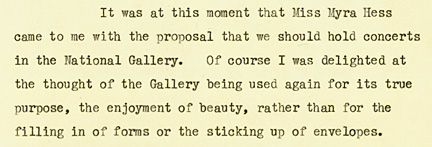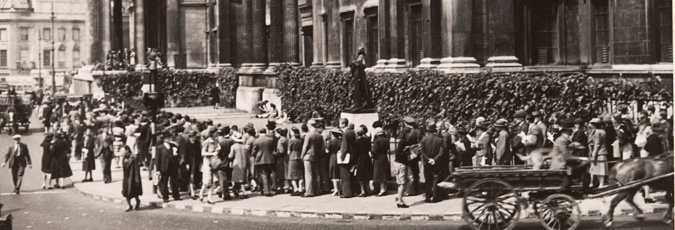The idea
The bold decision to turn one of London’s major art galleries into a venue for musical concerts was taken little more than a month after the outbreak of war in September 1939. It was the result of what Kenneth Clark, the National Gallery’s Director, called ‘the cultural black-out’ that followed the announcement of hostilities.
Wartime view of National Gallery
As the real black-out came into force, and the city fell dark at night, its theatres, galleries, cinemas, and concert halls shut their doors in response to a government ruling. Bombing raids were a serious threat and the Home Office was keen to avoid the mass casualties that would ensue if public venues were targeted.
The National Gallery closed on 23 August 1939, the evacuation of its pictures having already begun. Every day containers of paintings left London for secret destinations in Gloucestershire and Wales, where they could be kept safe. Find out where the paintings were stored and how the Gallery fared during wartime.
Clark described the scene following the departure of the paintings: ‘Every picture had been taken away, but the frames remained and multiplied the general emptiness with a series of smaller emptinesses. When I returned to the Gallery, after the first all-absorbing task of evacuation was more or less safely over, I walked round those large, dirty, and (as it turned out) ill-proportioned rooms, in deep depression.’
The National Gallery in wartime
Transcript
Suzanne Bosman: The paintings were moved out of the Gallery just before war was declared over a period of 10 days, and on the 2nd September all the paintings that were going to be evacuated had left London.
Alan Crookham: The paintings were scattered over several sites in Wales and one in Gloucester and then they became slightly concerned, after the fall of France in 1940, that the paintings that had been evacuated to Wales weren’t as secure as they thought they were because they were stored in country houses, in university halls of residence, so they were still stored above ground. So they therefore dispersed the paintings further, that was their initial response, but what they did for a more long term solution was to look for an underground storage site. So Ian Rawlins, who was the chief scientific officer here at the Gallery at the time, he found a location in North Wales near Blaenau Ffestiniog quarry - a slate quarry called Manod - and that seemed to offer the solution. The Government agreed, they agreed to pay for its conversion. They had to widen the entrance and they had to build little brick store rooms inside the caves to protect the paintings and in order to also to provide them with a stable environment. They moved the paintings up to Manod in 1941 and that’s pretty much where they stayed until 1945.
Suzanne Bosman: Kenneth Clark, the Director at the time, was walking through the empty forlorn galleries with frames leaning against the walls without their famous masterpieces and he recounted how he was really depressed on seeing this site and especially on the thought that he was going to have to give over the building to some anonymous war ministry for the filling of envelopes and typing of reports. So imagine his joy when he had an unexpected visit in those first few days of the war, when Myra Hess, the famous pianist, came to see him with a revolutionary idea; she suggested organising a weekly concert to take place in the Gallery. So the concerts began only a few weeks after war was declared. They were organised in a record number of days and in fact the first one was performed in October and the first concert was an absolute roaring success.
With the pictures evacuated, the Director waited for notification that the Gallery would be requisitioned for administrative purposes, saddened by its inability to offer Londoners comfort just when they needed it most.
Then one day, just a few weeks after the outbreak of war, he was visited by the famous pianist, Myra Hess. She shared his dismay. The arts, she believed, played a powerful spiritual role in the health of the nation at the best of times – and would play an greater role now during wartime.
Hess proposed using the Gallery as a venue for music – and the Director agreed. There was precedent after all, for concerts had been given at the Gallery to raise funds during a brief period in 1922.

And as Clark told listeners to a radio broadcast a month or so later, he ‘was delighted at the thought of the Gallery being used again for its true purposes, the enjoyment of beauty, rather than for the filling in of forms or the sticking up of envelopes’. Asked whether it might be possible to give an occasional lunchtime concert at the venue, he replied, ‘Why not give one every day?’
Next: Preparations

